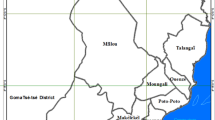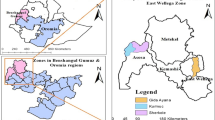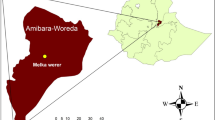Abstract
Symptomatic and asymptomatic malaria patients are considered as the reservoirs of human Plasmodium. In the present study, we have evaluated the Plasmodium falciparum merozoite surface protein-1 (Pfmsp1) and protein-2 (Pfmsp2) genetic diversity among the symptomatic and asymptomatic malaria infection from health facilities in Cotonou, Benin Republic. A cross-sectional study recruited 158 individuals, including 77 from the asymptomatic and 81 from the symptomatic groups. The parasites were genotyped using Nested Polymerase Chain Reaction. Samples identified as Plasmodium falciparum were genotyped for their genetic diversity. No significant difference was observed in the overall multiplicity of infection (MOI) between the asymptomatic and symptomatic groups. In the symptomatic group, the overall frequency of K1, MAD20, and RO33 allelic family was more predominant (98.5%) followed by 3D7 (87.3%) and FC27 (83.1%). However, in asymptomatic group, the K1 alleles were the most prevalent (100%) followed by FC27 (89.9%), 3D7 (76.8%), MAD20 (60.5%), and RO33 (35.5%). The frequency of multiple allelic types (K1+MAD20+RO33) at the Pfmsp1 loci in the symptomatic infections was significantly higher when compared to that of the asymptomatic ones (97% vs. 34%, p < 0.05), whereas no difference was observed in the frequency of multiple allelic types (3D7 and FC27) at the Pfmsp2 loci between the two groups. The high presence of msp1 multiple infections in the symptomatic group compared to asymptomatic ones suggests an association between the genetic diversity and the onset of malaria symptoms. These data can provide valuable information in the development of a vaccine that could reduce the symptomatic disease.



Similar content being viewed by others
Data availability
All data generated or analyzed during this study are included in the article.
References
Abdel-Wahab A, Abdel-Muhsin A-MA, Ali E et al (2002) Dynamics of gametocytes among Plasmodium falciparum clones in natural infections in an area of highly seasonal transmission. J Infect Dis 185:1838–1842. https://doi.org/10.1086/340638
A-Elbasit IE, Elghazali G, A-Elgadir TME et al (2007) Allelic polymorphism of MSP2 gene in severe P. falciparum malaria in an area of low and seasonal transmission. Parasitol Res 102:29–34. https://doi.org/10.1007/s00436-007-0716-3
Agyeman-Budu A, Brown C, Adjei G et al (2013) Trends in multiplicity of Plasmodium falciparum infections among asymptomatic residents in the middle belt of Ghana. Malar J 12:22. https://doi.org/10.1186/1475-2875-12-22
Al-Yaman F, Genton B, Taraika J et al (1997) Cellular immunity to merozoite surface protein 2 (FC27 and 3D7) in Papua New Guinean children. Temporal variation and relation to clinical and parasitological status. Parasite Immunol 19:207–214. https://doi.org/10.1046/j.1365-3024.1997.d01-198.x
Anong DN, Nkuo-Akenji T, Fru-Cho J et al (2010) Genetic diversity of Plasmodium falciparum in Bolifamba, on the slopes of Mount Cameroon: influence of MSP1 allelic variants on symptomatic malaria and anaemia. Ann Trop Med Parasitol 104:25–33. https://doi.org/10.1179/136485910X12607012373876
Arnot D (1998) Unstable malaria in Sudan: the influence of the dry season. Clone multiplicity of Plasmodium falciparum infections in individuals exposed to variable levels of disease transmission. Trans R Soc Trop Med Hyg 92:580–585. https://doi.org/10.1016/s0035-9203(98)90773-8
Ayanful-Torgby R, Oppong A, Abankwa J et al (2016) Plasmodium falciparum genotype and gametocyte prevalence in children with uncomplicated malaria in coastal Ghana. Malar J 15:592. https://doi.org/10.1186/s12936-016-1640-8
Barat LM, Palmer N, Basu S, et al (2004) Do malaria control interventions reach the poor? A view through the equity lens. American Society of Tropical Medicine and Hygiene
Barry AE, Schultz L, Senn N et al (2013) High levels of genetic diversity of Plasmodium falciparum populations in Papua New Guinea despite variable infection prevalence. Am J Trop Med Hyg 88:718–725. https://doi.org/10.4269/ajtmh.12-0056
Bousema T, Okell L, Felger I, Drakeley C (2014) Asymptomatic malaria infections: detectability, transmissibility and public health relevance. Nat Rev Microbiol 12:833–840. https://doi.org/10.1038/nrmicro3364
Carmona-Fonseca J, Agudelo OM, Arango EM (2017) Asymptomatic plasmodial infection in Colombian pregnant women. Acta Trop 172:97–101. https://doi.org/10.1016/j.actatropica.2017.04.030
Chen J-T, Li J, Zha G-C et al (2018) Genetic diversity and allele frequencies of Plasmodium falciparum msp1 and msp2 in parasite isolates from Bioko Island. Equatorial Guinea Malaria Journal 17:458. https://doi.org/10.1186/s12936-018-2611-z
Congpuong K, Sukaram R, Prompan Y, Dornae A (2014) Genetic diversity of the msp-1, msp-2, and glurp genes of Plasmodium falciparum isolates along the Thai-Myanmar borders. Asian Pac J Trop Biomed 4:598–602. https://doi.org/10.12980/APJTB.4.2014APJTB-2014-0156
Contamin H, Fandeur T, Bonnefoy S, et al (1995) PCR typing of field isolates of Plasmodium falciparum. J Clin Microbiol 33:944–951. https://doi.org/10.1128/jcm.33.4.944-951.1995
Conway DJ, Greenwood BM, McBride JS (1991) The epidemiology of multiple-clone Plasmodium falciparum infections in Gambian patients. Parasitology 103(Pt 1):1–6. https://doi.org/10.1017/s0031182000059217
Daubersies P, Sallenave-Sales S, Magne S et al (1996) Rapid turnover of Plasmodium falciparum populations in asymptomatic individuals living in a high transmission area. The American journal of tropical medicine and hygiene 54:18–26. https://doi.org/10.4269/ajtmh.1996.54.18
Durand R, Ariey F, Cojean S et al (2008) Analysis of circulating populations of Plasmodium falciparum in mild and severe malaria in two different epidemiological patterns in Madagascar. Tropical Med Int Health 13:1392–1399. https://doi.org/10.1111/j.1365-3156.2008.02156.x
Earland D, Buchwald AG, Sixpence A, et al (2019) Impact of multiplicity of plasmodium falciparum Infection on clinical disease in malawi. Am J Trop Med Hyg 101:412–415. https://doi.org/10.4269/ajtmh.19-0093
Färnert A, Arez AP, Babiker HA, et al (2001) Genotyping of Plasmodium falciparum infections by PCR: a comparative multicentre study. Trans R Soc Trop Med Hyg 95:225–232. https://doi.org/10.1016/s0035-9203(01)90175-0
Ferreira MU, Hartl DL (2007) Plasmodium falciparum: worldwide sequence diversity and evolution of the malaria vaccine candidate merozoite surface protein-2 (MSP-2). Exp Parasitol 115:32–40. https://doi.org/10.1016/j.exppara.2006.05.003
Genton B, Betuela I, Felger I et al (2002) A recombinant blood-stage malaria vaccine reduces Plasmodium falciparum density and exerts selective pressure on parasite populations in a phase 1-2b trial in Papua New Guinea. J Infect Dis 185:820–827. https://doi.org/10.1086/339342
Ghanchi NK, Hasan Z, Islam M, Beg MA (2015) MAD 20 alleles of merozoite surface protein-1 (msp-1) are associated with severe Plasmodium falciparum malaria in Pakistan. J Microbiol Immunol Infect 48:213–218. https://doi.org/10.1016/j.jmii.2014.01.004
Gosling RD, Cairns ME, Chico RM, Chandramohan D (2010) Intermittent preventive treatment against malaria: an update. Expert Rev Anti-Infect Ther 8:589–606. https://doi.org/10.1586/eri.10.36
Healer J, Murphy V, Hodder AN et al (2004) Allelic polymorphisms in apical membrane antigen-1 are responsible for evasion of antibody-mediated inhibition in Plasmodium falciparum. Mol Microbiol 52:159–168. https://doi.org/10.1111/j.1365-2958.2003.03974.x
Josling GA, Llinás M (2015) Sexual development in Plasmodium parasites: knowing when it’s time to commit. Nat Rev Microbiol 13:573–587. https://doi.org/10.1038/nrmicro3519
Juliano JJ, Porter K, Mwapasa V et al (2010) Exposing malaria in-host diversity and estimating population diversity by capture-recapture using massively parallel pyrosequencing. PNAS 107:20138–20143. https://doi.org/10.1073/pnas.1007068107
Kiwuwa MS, Ribacke U, Moll K et al (2013) Genetic diversity of Plasmodium falciparum infections in mild and severe malaria of children from Kampala, Uganda. Parasitol Res 112:1691–1700. https://doi.org/10.1007/s00436-013-3325-3
Koepfli C, Ross A, Kiniboro B et al (2011) Multiplicity and diversity of Plasmodium vivax infections in a highly endemic region in Papua New Guinea. PLoS Negl Trop Dis 5:e1424. https://doi.org/10.1371/journal.pntd.0001424
Kolakovich KA, Ssengoba A, Wojcik K et al (1996) Plasmodium vivax: favored gene frequencies of the merozoite surface protein-1 and the multiplicity of infection in a malaria endemic region. Exp Parasitol 83:11–19. https://doi.org/10.1006/expr.1996.0044
Lin JT, Hathaway NJ, Saunders DL et al (2015) Using amplicon deep sequencing to detect genetic signatures of Plasmodium vivax relapse. J Infect Dis 212:999–1008. https://doi.org/10.1093/infdis/jiv142
Lindblade KA, Steinhardt L, Samuels A et al (2013) The silent threat: asymptomatic parasitemia and malaria transmission. Expert Rev Anti-Infect Ther 11:623–639. https://doi.org/10.1586/eri.13.45
Mahmoudi S, Keshavarz H (2018) Malaria vaccine development: the need for novel approaches: a review article. Iran J Parasitol 13:1–10
Miller LH, Baruch DI, Marsh K, Doumbo OK (2002) The pathogenic basis of malaria. Nature 415:673–679. https://doi.org/10.1038/415673a
Mohd Abd Razak MR, Sastu UR, Norahmad NA et al (2016) Genetic diversity of Plasmodium falciparum populations in malaria declining areas of Sabah, East Malaysia. PLoS One 11:e0152415. https://doi.org/10.1371/journal.pone.0152415
Ofosu-Okyere A, Mackinnon MJ, Sowa MP et al (2001) Novel Plasmodium falciparum clones and rising clone multiplicities are associated with the increase in malaria morbidity in Ghanaian children during the transition into the high transmission season. Parasitology 123:113–123. https://doi.org/10.1017/s0031182001008162
Patel P, Bharti PK, Bansal D et al (2017) Genetic diversity and antibody responses against Plasmodium falciparum vaccine candidate genes from Chhattisgarh, Central India: implication for vaccine development. PLoS One 12:e0182674. https://doi.org/10.1371/journal.pone.0182674
Paul RE, Hackford I, Brockman A et al (1998) Transmission intensity and Plasmodium falciparum diversity on the northwestern border of Thailand. Am J Trop Med Hyg 58:195–203. https://doi.org/10.4269/ajtmh.1998.58.195
Ramaswamy A, Mahabala C, Basavaiah SH et al (2020) Asymptomatic malaria carriers and their characterization in hotpops of malaria at Mangalore. Tropical Parasitology 10:24. https://doi.org/10.4103/tp.TP_71_18
Richards JS, Beeson JG (2009) The future for blood-stage vaccines against malaria. Immunol Cell Biol 87:377–390. https://doi.org/10.1038/icb.2009.27
Robert F, Ntoumi F, Angel G et al (1996) Extensive genetic diversity of Plasmodium falciparum isolates collected from patients with severe malaria in Dakar, Senegal. Trans R Soc Trop Med Hyg 90:704–711. https://doi.org/10.1016/s0035-9203(96)90446-0
Snounou G, Viriyakosol S, Zhu XP et al (1993) High sensitivity of detection of human malaria parasites by the use of nested polymerase chain reaction. Mol Biochem Parasitol 61:315–320. https://doi.org/10.1016/0166-6851(93)90077-b
Somé AF, Bazié T, Zongo I et al (2018) Plasmodium falciparum msp1 and msp2 genetic diversity and allele frequencies in parasites isolated from symptomatic malaria patients in Bobo-Dioulasso. Burkina Faso Parasites Vectors 11:323. https://doi.org/10.1186/s13071-018-2895-4
Sondo P, Derra K, Lefevre T et al (2019) Genetically diverse Plasmodium falciparum infections, within-host competition and symptomatic malaria in humans. Sci Rep 9:127. https://doi.org/10.1038/s41598-018-36493-y
Tusting LS, Bousema T, Smith DL, Drakeley C (2014) Measuring changes in Plasmodium falciparum transmission: precision, accuracy and costs of metrics. Adv Parasitol 84:151–208. https://doi.org/10.1016/B978-0-12-800099-1.00003-X
Vafa M, Troye-Blomberg M, Anchang J et al (2008) Multiplicity of Plasmodium falciparum infection in asymptomatic children in Senegal: relation to transmission, age and erythrocyte variants. Malar J 7:17. https://doi.org/10.1186/1475-2875-7-17
WHO technical consultation to review the role of drugs in malaria prevention for people living in endemic settings (2019). https://www.who.int/publications/m/item/who-technical-consultation-to-review-the-role-of-drugs-in-malaria-prevention-for-people-living-in-endemic-settings. Accessed 25 May 2021
Wooden J, Kyes S, Sibley CH (1993) PCR and strain identification in Plasmodium falciparum. Parasitol Today 9:303–305. https://doi.org/10.1016/0169-4758(93)90131-x
Yavo W, Konaté A, Mawili-Mboumba DP et al (2016) Genetic Polymorphism of msp1 and msp2 in Plasmodium falciparum Isolates from Côte d’Ivoire versus Gabon. J Parasitol Res 2016:3074803. https://doi.org/10.1155/2016/3074803
Acknowledgements
The authors thank all malaria patients who participated in the study. Also, we would like to thank the team of Tropical Infectious Diseases Research Centre and Laboratory of Infectious Vector-Borne Diseases, University of Abomey-Calavi, for participating in the field and laboratory work.
Funding
This work was supported by Wellcome Trust (intermediate fellowship in public health and tropical medicine n° 109917/Z/15/Z) awarded to Luc Salako DJOGBENOU.
Author information
Authors and Affiliations
Contributions
Hamirath Odée Lagnika, Azizath Moussiliou, and Luc Salako Djogbenou conceived and designed the study. Hamirath Odée Lagnika, Azizath Moussiliou, and Laurette Djossou performed the experiments. Hamirath Odée Lagnika analyzed the data. Hamirath Odée Lagnika, Romuald Agonhossou, Pierre Sovegnon, Oswald Yédjinnavênan Djihinto, Adandé Assogba Medjigbodo, Aurore Ogouyemi-Hounto, Linda Eva Amoah, and Luc Salako Djogbenou performed drafting and substantial revision of the manuscript. All authors read and approved the final version of the manuscript.
Corresponding author
Ethics declarations
Competing interests
The authors declare no competing interests.
Additional information
Section Editor: Kevin S.W. Tan
Publisher’s note
Springer Nature remains neutral with regard to jurisdictional claims in published maps and institutional affiliations.
Rights and permissions
About this article
Cite this article
Lagnika, H.O., Moussiliou, A., Agonhossou, R. et al. Plasmodium falciparum msp1 and msp2 genetic diversity in parasites isolated from symptomatic and asymptomatic malaria subjects in the South of Benin. Parasitol Res 121, 167–175 (2022). https://doi.org/10.1007/s00436-021-07399-y
Received:
Accepted:
Published:
Issue Date:
DOI: https://doi.org/10.1007/s00436-021-07399-y




